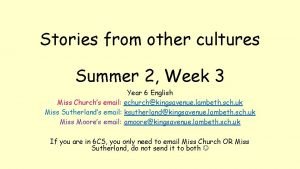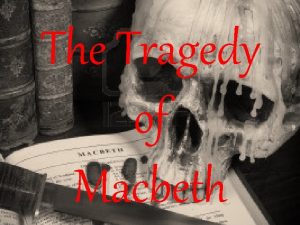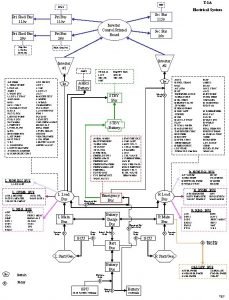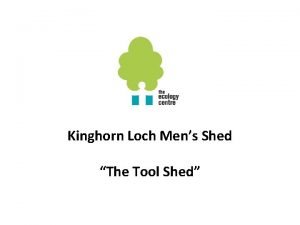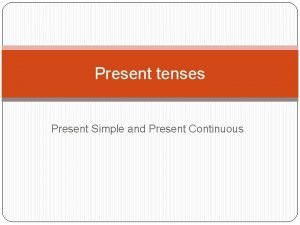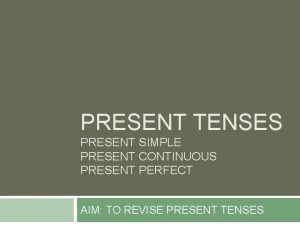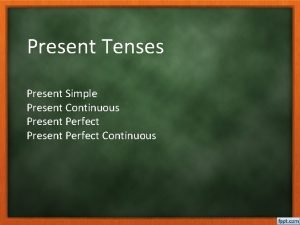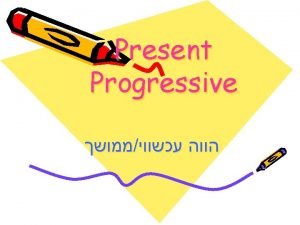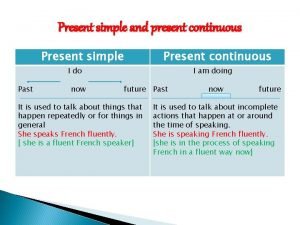The aim of present study is to shed











- Slides: 11

The aim of present study is to shed light on constructivism and its implication in curriculum development, and how constructivism shapes the development of materials. Constructivism takes an interdisciplinary perspective, inasmuch as it draws upon a diversity of psychological, sociological, philosophical, and critical educational theories. Viewing this, one can say that constructivism is an overarching theory that does not intend to wipe off but reconstruct past and present teaching and learning theories.

� Weinstein (2001) believes that there a wide variety of approaches to ESL instruction, each with underlying assumptions about teaching and learning, as well as associated techniques and procedures. Weinstein continues that a constructivist orientation to teaching and learning is one in which it is assumed that knowledge is not only transmitted to learners from teachers or books, but also that both meaning and knowledge can be created collectively by learners or by learners and teachers. According to Mc. Neil (2006), constructivists believe that they can provide a structure and a set of plans that will support the development of informed exploration and reflective inquiry without taking control away from the student. He continues that the learning opportunity must stimulate students to ask questions, pose problems, and set goals. Brown (2000) explains that constructivists argue that all human beings construct their own version of reality, and therefore multiple contrasting ways of knowing and describing are equally legitimate.

�Hawkins (2001) argues that a constructivist approach to instruction relies on the integration of cognitive, social, and linguistic features to achieve the classroom discourse that promotes learning to do content. To understand or know something, one must use cognitive powers of elucidation to construct meaning; this only happens when language and social knowledge are closely integrated with cognition. She argues that even when we work independently, we are involved in this integrated triad of cognition, language, and social knowledge.

� Nunan (2004) defines constructivism as a philosophical approach arguing that knowledge is socially constructed rather than having its own independent existence. Nunan refers to experiential learning as a constructivist model. He explains that experiential learning has diverse roots in a range of disciplines from social psychology, humanistic education, developmental education and cognitive theory. Kohonen (1992) provided the most articulate application of experiential learning to language teaching. The following lists of percepts for action have been derived from his work: � Encourage the transformation of knowledge within the learner rather than the transmission of knowledge from the teacher to the learner. � Encourage learners to participate actively in small, collaborative groups. � Embrace a holistic attitude towards subject matter rather than a static, atomistic and hierarchical attitude. � Emphasize process rather than product, learning how to learn, self-inquiry, social and communication skills. � Encourage self-directed rather than teacher-directed learning. � Promote intrinsic rather than extrinsic motivation.

�According to Vygotsky (1978), the constructivist movement in recent cognitive psychology has reemphasized the active role students play in acquiring knowledge and the social construction of Knowledge has been an important principle in socio-cultural theory. Terwel (1999) emphasizes that constructivism undoubtedly has a valuable contribution to make to curriculum theory and practice. However, constructivism is not a robust concept. It seems to flourish only under more or less ideal educational circumstances. Some important questions derive from this understanding. If knowledge-construction and curriculum creation take place between teachers and students in the classroom, then what are the conditions under which this process can succeed? What are the possible dangers in allowing teachers and students to construct their own knowledge, knowing that they may get disconnected from the subject?

�Terwel (1999) continues although the idea of the classroom as a community of inquiry is attractive, there needs to be a close connection to knowledgeproducing communities. In the light of such issues and given current practice, there is the distinct possibility that radical constructivism in education will fail to overcome the enemies of all acquisition of true knowledge: prejudices, naive concepts, misconceptions, subjectivism, solipsism and uncommitted relativism.

�Seixas (1993 cited in Terwel 1999) proposes to give teachers the opportunity to participate actively in educational research and, in doing so, to establish connections between isolated communities of practice

�He seems to look for a practical solution that is establishing connections between theory and practice, and putting deliberation at the very heart of curriculum development and implementation. The constructivist and `situated learning’ movement offers a significant challenge for curriculum theory, practice, and research.

�Time, effort, and deliberation will be needed before any constructivist curriculum practice can be envisaged on a national scale

� REFERENCES � Brown, D. (2000). Principles of language learning and teaching. London: Longman. � Clark, J. L. (1987). Curriculum renewal in school foreign language learning. Oxford: OUP. � Hawkins, B. (2001). Supporting second language children’s content learning and language development. In M. Celce-Murcia (Ed. ), Teaching English as a second or foreign language. (pp. 367383). Melbourne: Henile & Henile. � Kohonen, V. (1992). Experiential language learning: Second language learning as cooperative learner education. In D. Nunan (Ed. ), Collaborative language learning and teaching. (pp. 14 -39). Cambridge: CUP. � Nunan, D. (2004). Task-based language teaching. Cambridge: CUP. � Mc Neil, J. D. (2006). Contemporary curriculum. NJ: John Wiley & Sons, INC. � Richards, J. C. (2001). Curriculum development in language teaching. Cambridge: CUP.

� Terwel, J. (1999). Constructivism and its implications for curriculum theory and practice, Curriculum Studies, 31 (2), 195199. � Vygotsky, L. S. (1978). Mind in society: The development of higher psychological processes. Cambridge: Harvard University Press. � Weinstein, G. (2001). Developing adult literacies. In M. Celce. Murcia (Ed. ), Teaching English as a second or foreign language. (pp. 171 -181). Melbourne: Henile & Henile.


